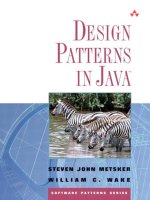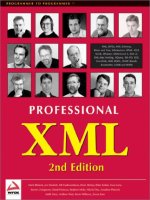OReilly IPv6 essentials 2nd edition may 2006 ISBN 0596100582
Bạn đang xem bản rút gọn của tài liệu. Xem và tải ngay bản đầy đủ của tài liệu tại đây (8.12 MB, 836 trang )
IPv6Essentials
BySilviaHagen
...............................................
Publisher:O'Reilly
PubDate:May2006
PrintISBN-10:0-596-10058-2
PrintISBN-13:978-0-59-610058-2
Pages:436
TableofContents|Index
IPv6Essentials,SecondEditionprovidesasuccinct,in-depthtourofallthenewfeatures
andfunctionsinIPv6.Itguidesyouthrougheverythingyouneedtoknowtogetstarted,
includinghowtoconfigureIPv6onhostsandroutersandwhichapplicationscurrently
supportIPv6.ThenewIPv6protocolsoffersextendedaddressspace,scalability,improved
supportforsecurity,real-timetrafficsupport,andauto-configurationsothatevenanovice
usercanconnectamachinetotheInternet.Aimedatsystemandnetworkadministrators,
engineers,networkdesigners,andITmanagers,thisbookwillhelpyouunderstand,plan
for,design,andintegrateIPv6intoyourcurrentIPv4infrastructure.
BeginningwithashorthistoryofIPv6,authorSilviaHagenprovidesanoverviewofnew
functionalityanddiscusseswhyweneedIPv6.Hagenalsosharesexhaustivediscussionsof
thenewIPv6headerformatandExtensionHeaders,IPv6addressandICMPv6message
format,Security,QoS,Mobilityand,lastbutnotleast,offersaQuickStartGuidefor
differentoperatingsystems.IPv6Essentials,SecondEditionalsocovers:
In-depthtechnicalguidetoIPv6
MechanismsandCaseStudiesthatshowhowtointegrateIPv6intoyournetwork
withoutinterruptionofIPv4services
Routingprotocolsandupperlayerprotocols
SecurityinIPv6:conceptsandrequirements.IncludestheIPSECframeworkand
securityelementsavailableforauthenticationandencryption
QualityofService:coverstheelementsavailableforQoSinIPv6andhowtheycan
beimplemented
DetaileddiscussionofDHCPv6andMobileIPv6
Discussionofmigrationcostandbusinesscase
Gettingstartedondifferentoperatingsystems:SunSolaris,Linux,BSD,WindowsXP,
andCiscorouters
Whetheryou'rereadytostartimplementingIPv6todayorareplanningyourstrategyfor
thefuture,IPv6Essentials,SecondEditionwillprovidethesolidfoundationyouneedto
getstarted.
"Silvia'slookatIPv6isalwaysrefreshingasshetranslatescomplex
technologyfeaturesintobusinessdriversandgenuineend-userbenefitsto
enablebuildingnewbusinessconceptsbasedonendtoendmodels."
LatifLadid,PresidentIPv6Forum,ChairEUIPv6TaskForce
IPv6Essentials
BySilviaHagen
...............................................
Publisher:O'Reilly
PubDate:May2006
PrintISBN-10:0-596-10058-2
PrintISBN-13:978-0-59-610058-2
Pages:436
TableofContents|Index
Copyright
Preface
Chapter1.WhyIPv6?
Section1.1.TheHistoryofIPv6
Section1.2.What'sNewinIPv6?
Section1.3.WhyDoWeNeedIPv6?
Section1.4.CommonMisconceptions
Section1.5.WhenIsItTimeforIPv6?
Section1.6.IPv6AroundtheWorld
Section1.7.IPv6StatusandVendorSupport
Section1.8.References
Chapter2.TheStructureoftheIPv6Protocol
Section2.1.GeneralHeaderStructure
Section2.2.TheFieldsintheIPv6Header
Section2.3.ExtensionHeaders
Section2.4.References
Chapter3.IPv6Addressing
Section3.1.TheIPv6AddressSpace
Section3.2.AddressTypes
Section3.3.AddressNotation
Section3.4.PrefixNotation
Section3.5.GlobalRoutingPrefixes
Section3.6.GlobalUnicastAddress
Section3.7.SpecialAddresses
Section3.8.Link-andSite-LocalAddresses
Section3.9.AnycastAddress
Section3.10.MulticastAddress
Section3.11.RequiredAddresses
Section3.12.DefaultAddressSelection
Section3.13.References
Chapter4.ICMPv6
Section4.1.GeneralMessageFormat
Section4.2.ICMPErrorMessages
Section4.3.ICMPInformationalMessages
Section4.4.ProcessingRules
Section4.5.TheICMPv6HeaderinaTraceFile
Section4.6.NeighborDiscovery(ND)
Section4.7.Autoconfiguration
Section4.8.NetworkRenumbering
Section4.9.PathMTUDiscovery
Section4.10.MulticastListenerDiscovery(MLD)
Section4.11.MulticastRouterDiscovery(MRD)
Section4.12.References
Chapter5.SecuritywithIPv6
Section5.1.GeneralSecurityConcepts
Section5.2.GeneralSecurityPractices
Section5.3.IPsecBasics
Section5.4.IPv6SecurityElements
Section5.5.OverviewofNewIPsecRFCs
Section5.6.InteractionofIPsecwithIPv6Elements
Section5.7.IPv6Security"Gotchas"
Section5.8.EnterpriseSecurityModelsforIPv6
Section5.9.References
Chapter6.QualityofService
Section6.1.QoSBasics
Section6.2.QoSinIPv6Protocols
Section6.3.UsingQoS
Section6.4.References
Chapter7.NetworkingAspects
Section7.1.Layer2SupportforIPv6
Section7.2.DetectingNetworkAttachment(DNA)
Section7.3.References
Chapter8.RoutingProtocols
Section8.1.TheRoutingTable
Section8.2.RIPng
Section8.3.OSPFforIPv6(OSPFv3)
Section8.4.BGP-4SupportforIPv6
Section8.5.AdditionalRoutingProtocolsforIPv6
Section8.6.References
Chapter9.Upper-LayerProtocols
Section9.1.UDP/TCP
Section9.2.DHCP
Section9.3.DNS
Section9.4.SLP
Section9.5.FTP
Section9.6.Telnet
Section9.7.WebServers
Section9.8.References
Chapter10.Interoperability
Section10.1.Dual-StackTechniques
Section10.2.TunnelingTechniques
Section10.3.NetworkAddressandProtocolTranslation
Section10.4.Comparison
Section10.5.IntegrationScenarios
Section10.6.CaseStudies
Section10.7.WhatIsMissing?
Section10.8.SecurityAspects
Section10.9.Applications
Section10.10.CostofIntroduction
Section10.11.VendorSupport
Section10.12.References
Chapter11.MobileIPv6
Section11.1.Overview
Section11.2.TheMobileIPv6Protocol
Section11.3.ICMPv6andMobileIPv6
Section11.4.MobileIPv6Communication
Section11.5.Security
Section11.6.ExtensionstoMobileIPv6
Section11.7.References
Chapter12.GetYourHandsDirty
Section12.1.Linux
Section12.2.BSD
Section12.3.SunSolaris
Section12.4.Macintosh
Section12.5.Microsoft
Section12.6.CiscoRouter
Section12.7.Applications
Section12.8.DescriptionoftheTests
RFCs
SectionA.1.GeneralRFCInformation
SectionA.2.Drafts
SectionA.3.RFCIndexforIPv6
IPv6Resources
SectionB.1.EthertypeField
SectionB.2.NextHeaderFieldValues(Chapter2)
SectionB.3.ReservedAnycastIDs(Chapter3,RFC2526)
SectionB.4.ValuesfortheMulticastScopeField(Chapter3,RFC4291)
SectionB.5.Well-KnownMulticastGroupAddresses(Chapter3,RFC2375)
SectionB.6.ICMPv6MessageTypesandCodeValues(Chapter4,RFC2463)
SectionB.7.QoSinIPv6(Chapter6)
SectionB.8.MulticastGroupAddressesandTokenRingFunctionalAddresses
(Chapter7)
SectionB.9.OSPFv3MessagesandtheLinkStateDatabase(Chapter8)
SectionB.10.BGP-4MessageTypesandParameters(Chapter8)
SectionB.11.DHCPv6andMulticastAddressesforSLPoverIPv6(Chapter9)
SectionB.12.MobileIPv6(Chapter11,RFC3775)
RecommendedReading
AbouttheAuthor
Colophon
Index
IPv6Essentials,SecondEdition
bySilviaHagen
Copyright©2006,2002O'ReillyMedia,Inc.Allrightsreserved.
PrintedintheUnitedStatesofAmerica.
PublishedbyO'ReillyMedia,Inc.,1005GravensteinHighway
North,Sebastopol,CA95472.
O'Reillybooksmaybepurchasedforeducational,business,or
salespromotionaluse.Onlineeditionsarealsoavailablefor
mosttitles(safari.oreilly.com).Formoreinformation,contact
ourcorporate/institutionalsalesdepartment:(800)998-9938or
Editor:TatianaApandiandMikeLoukides
ProductionEditors:RebaLibbyandGenevieved'Entremont
Copyeditor:RebaLibby
Proofreader:Genevieved'Entremont
Indexer:JohnBickelhaupt
CoverDesigner:HannaDyer
InteriorDesigner:DavidFutato
Illustrators:RobertRomanoandJessamynRead
PrintingHistory:
May2006:SecondEdition.
July2002:FirstEdition.
NutshellHandbook,theNutshellHandbooklogo,andthe
O'ReillylogoareregisteredtrademarksofO'ReillyMedia,Inc.
IPv6Essentials,theimageofarigatellasnail,andrelatedtrade
dressaretrademarksofO'ReillyMedia,Inc.
Manyofthedesignationsusedbymanufacturersandsellersto
distinguishtheirproductsareclaimedastrademarks.Where
thosedesignationsappearinthisbook,andO'ReillyMedia,Inc.
wasawareofatrademarkclaim,thedesignationshavebeen
printedincapsorinitialcaps.
Whileeveryprecautionhasbeentakeninthepreparationofthis
book,thepublisherandauthor(s)assumenoresponsibilityfor
errorsoromissions,orfordamagesresultingfromtheuseof
theinformationcontainedherein.
ISBN:0-596-10058-2
[M]
Preface
ThisbookisaboutthenextgenerationInternetprotocol.We
havebecomefamiliarwiththestrengthsandweaknessesof
IPv4;weknowhowtodesignandconfigureit,andwehave
learnedhowtotroubleshootit.Andnowwehavetolearnanew
protocol?Startfromscratch?Notreally.ThedesignersofIPv6
havelearnedalotfromover15yearsofexperiencewithIPv4,
andtheyhavebeenworkingonthenewprotocolsincetheearly
1990s.TheyretainedthestrengthsofIPv4,extendedthe
addressspacefrom32bitsto128bits,andaddedfunctionality
thatismissinginIPv4.Theydevelopedtransitionmechanisms
thatmakeIPv4andIPv6coexistpeacefullyandthatguarantee
asmoothtransitionbetweentheprotocols.Infact,thiswasone
ofthemajorrequirementsforthedevelopmentofthenew
protocolversion.
SoyoudonotneedtoforgetwhatyouknowaboutIPv4;many
thingswillfeelfamiliarwithIPv6.Whenyougetstarted,you
willdiscovernewfeaturesandfunctionalitiesthatwillmake
yourlifealoteasier.IPv6hasfeaturesthatyouwillneedin
tomorrow'snetworksfeaturesthatIPv4doesnotprovide.The
daywillcomewhenourPersonalDigitalAssistants(PDAs)and
mobilephoneshaveIPaddresses.Asidefromthefactthatthe
IPv4addressspacecouldnevercoverthedemandforthat
numberofIPaddresses,imagineconfiguringthosedeviceswith
themeanswehavetoday!
OneofthecoolestfeaturesbuiltintoIPv6isthe
autoconfigurationcapability.Haven'twealwaysstruggledwith
IPaddressassignment?TheadventofDHCPmadeourlivesa
littleeasier,butnowweneedtomaintainandtroubleshootthe
DHCPservers.Andwhenourrefrigerator,ourPDA,andourTV
eachhaveanIPaddress,willweneedaDHCPserverathome?
Notwithautoconfiguration.IfyouhaveanIPv6-enabledhost,
youcanplugitintoyournetwork,anditwillconfigure
automaticallyforavalidIPv6address.InternetControlMessage
Protocol(ICMP),whichisanetworker'sbestfriend,hasbecome
muchmorepowerfulwithIPv6.Manyofthenewfeaturesof
IPv6,suchasautoconfiguration,optimizedmulticastrouting
andmulticastgroupmanagement,NeighborDiscovery,path
MTUdiscovery,andMobileIPv6arebasedonICMPv6.
Ihopethatthisbookwillhelpyoutobecomefamiliarwiththe
protocolandprovideaneasy-to-understandentrypointand
guidetoexploringthisnewarea.
Audience
ThisbookcoversabroadrangeofinformationaboutIPv6andis
anexcellentresourceforanybodywhowantstounderstandor
implementtheprotocol.Whetheryouaretheownerormanager
ofacompanyoranITdepartment;whetheryouareasystem
ornetworkadministrator,anengineer,oranetworkdesigner;
orwhetheryouarejustgenerallyinterestedinlearningabout
theimportantchangeswithIPv6,thisbookdiscusseseconomic
andstrategicaspectsaswellastechnicaldetails.Idescribe
interoperabilitymechanismsandscenariosthatensurea
smoothintroductionofIPv6.Quickstartguidesfordifferent
operatingsystemshelpwiththefirsthands-onsteps.Ifyouare
acompanyownerormanager,youwillbemostinterestedin
Chapters1and10.Ifyouneedtoplanyourcorporatenetwork
strategy,youwillbemostinterestedinChapters1,4,8,9,and
10.Ifyoumanagetheinfrastructureinyourcompany,youwill
especiallybeinterestedinChapters4,7,and8,whichcover
ICMPv6,Layer2issuesandrouting,andinChapter10,which
addressesinteroperability.Ifyouareasystemornetwork
administrator,allchaptersarerelevant:thisbookprovidesa
foundationforIPv6implementationandintegrationwithIPv4.
AboutThisBook
ThisbookcoversIPv6indetailandexplainsallthenewfeatures
andfunctions.Itwillshowyouhowtoplanfor,design,and
integrateIPv6inyourcurrentIPv4infrastructure.Italso
teachesyouwhatyouneedtoknowtogetstarted,toconfigure
IPv6onyourhostsandrouters,andtofindtheright
applicationsthatsupportIPv6.
Nowthatyouknowwhatthisbookisabout,Ishouldexplain
thisthisbookisnotwrittenfordevelopers.Thisdoesn'tmean
youshouldnotbereadingitifyouareadeveloper.Ifyoudo
readit,youwillunderstandtheimplicationsofintroducingIPv6
inyournetworkandhowimportantitistodevelopcool
applicationsforIPv6.Ifyouneedaspecificguidetodeveloping
forIPv6,lookfordeveloperresources.
Thisbookassumesthatyouhaveagoodunderstandingof
networkissuesingeneralandafamiliaritywithIPv4.Itis
beyondthescopeofthisbooktodiscussIPv4conceptsin
detail.Irefertothemwhennecessary,butifyouwanttolearn
moreaboutIPv4,therearealotofgoodresourcesonthe
market.YoucanfindalistofbooksinAppendixC.
Organization
ThisbookisorganizedsothatareaderfamiliarwithIPv4can
easilylearnaboutthenewfeaturesinIPv6byreadingChapters
2through6.Thesechapterscoverwhatyouneedtoknow
aboutaddressing,thenewIPv6header,ICMPv6,security,and
QualityofService(QoS).Chapters7through11covertopics
suchasnetworkingaspects,supportofdifferentlink-layer
services,routing,upperlayerprotocolsupport,thetransition
mechanismsthatmakeIPv6interoperablewithIPv4,and
MobileIPv6.Chapter12isaquick-startguideandincludesa
shortdescriptionofhowdifferentoperatingsystemsare
configuredforIPv6.Hereisachapter-by-chapterbreakdownof
thebook:
Chapter1,WhyIPv6?,brieflyexplainsthehistoryofIPv6
andgivesanoverviewofthenewfunctionality.Itdrawsa
biggerpictureofInternetandserviceevolution,showing
thatthelargeaddressspaceandtheadvancedfunctionality
ofIPv6aremuchneededfordifferentreasons.Itthen
discussesthemostcommonmisconceptionsthatprevent
peoplefromexploringandintegratingtheprotocol,and
providesasummaryofthemostimportantstepsto
undertaketoday,alongwithapictureofwhatishappening
aroundtheworld.
Chapter2,TheStructureoftheIPv6Protocol,describesthe
newIPv6headerformatwithadiscussionofeachfieldand
tracefileexamples.ItalsodescribeswhatExtension
headersare,whattypesofExtensionheadershavebeen
defined,andhowtheyareused.
Chapter3,IPv6Addressing,explainseverythingyouneed
toknowaboutthenewaddressformat,addressnotation,
addresstypes,internationalregistryservices,andprefix
allocation.
Chapter4,ICMPv6,describesthenewICMPv6message
format,theICMPv6ErrormessagesandInformational
messages,andtheICMPv6headerinthetracefile.This
chapteralsodiscussestheextendedfunctionalitybasedon
ICMPv6,suchasNeighborDiscovery,Autoconfiguration,
PathMTUDiscovery,andMulticastListenerDiscovery
(MLD).YouwilllearnhowICMPv6makesanadministrator's
lifeeasier.
Chapter5,SecuritywithIPv6,beginswithashort
discussionofbasicsecurityconceptsandrequirements.It
thencoverstheIPsecframework,securityelements
availableinIPv6forauthenticationandencryption,andhow
theyareused.Ourfuturenetworkswillrequirenewsecurity
architectures.Thischapterincludesadescriptionofanew
model.
Chapter6,QualityofService,discussesbasicrequirements
andtypesofQoS.IexplaintheQoSelementsavailablein
IPv6andhowtheycanbeimplemented.Ialsodescribe
differentQoSarchitecturesandintroducefurtherworkin
thisarea.
Chapter7,NetworkingAspects,discussesLayer2support
forIPv6(Ethernet,TokenRing,ATM,framerelay,etc.),the
mappingofmulticastaddressestoLayer2addresses,and
theDetectingNetworkAttachment(DNA)workinggroup.
Chapter8,RoutingProtocols,discussestheadvanced
routingfeaturesofIPv6andcoverstheavailablerouting
protocolssuchasRIPng,OSPFv3forIPv6,andBGP
extensionsforIPv6,IS-IS,andEIGRPv6.(Thischapterwas
writtenbyStefanMarzohl.)
Chapter9,Upper-LayerProtocols,discusseswhatisgoing
onabovetheIPlayer,startingwithchangesforTCPand
UDP,continuingwithadetaileddiscussionoftheDHCPv6
specification,DNSextensionsforIPv6,SLPv2inIPv6
networks,FTP,Telnet,andwebservers.
Chapter10,Interoperability,discussesthedifferent
transitionmechanismsthathavebeendefined,suchas
dual-stackoperation,tunneling,andtranslationtechniques.
Italsoshowshowtheycanbeusedandcombinedtoensure
peacefulcoexistenceandsmoothtransition.Abroadvariety
ofcasestudiesshowthatIPv6ismatureenoughtobe
introducedandthattherearemanywaystodothis.Italso
providesanoverviewofwhatisstillmissing,securityand
applicationaspects,vendorstatus,andthecostof
introduction.
Chapter11,MobileIPv6,coversMobileIPv6.Thischapter
explainswhythistechnologywillbecomethefoundationfor
anewgenerationofmobileservices.
Chapter12,GetYourHandsDirty,explainshowtoget
startedwithIPv6ondifferentoperatingsystems,suchas
SunSolaris,Linux,BSD,Windows2003,WindowsXP,Mac
OS,andaCiscorouter.ItintroducesthemostcommonIPv6
toolsavailableforeachoperatingsystem.Thischapteralso
explainswhatIdidinmylabandprovidesexamplesof
tracefiles.
AppendixA,RFCs,includesashortintroductiontotheRFC
processandauthorities,andprovidesalistofrelevantRFCs
forIPv6.
AppendixB,IPv6Resources,reflectsthechapter
organizationofthebookandprovidessummariesofall
indexes,protocolnumbers,messagetypes,andaddress
allocations.
AppendixC,RecommendedReading,providesalistof
booksthatIrecommend.
Someimportanttopicsandinformationappearinmultiple
placesinthebook.ThisisnotbecauseIwanttoboreyou,but
becauseIassumethatmostreaderswillnotreadthebookfrom
thefirstpagetothelastpage,butratherwillpickandchoose
chaptersandsectionsdependingoninterest.Soifthe
informationisimportantwithregardtodifferentsectionsand
contexts,Imaymentionitagain.
ConventionsUsedinThisBook
Iusethefollowingfontconventionsinthisbook:
Italic
Usedtoindicatecommands,directorypaths,filenames,and
URLs.
Constantwidth
UsedtoindicateIPandMACaddresses,command-line
utilitiesandtools,interfaces,andflags.
Constantwidthitalic
Usedincodeexamplestoshowsampletexttobereplaced
withyourownvalues.
Constantwidthbold
Usedtohighlightportionsofcode,typicallynewadditionsto
oldcode.
UsingCodeExamples
Thisbookisheretohelpyougetyourjobdone.Ingeneral,you
mayusethecodeinthisbookinyourprogramsand
documentation.Youdonotneedtocontactusforpermission
unlessyou'rereproducingasignificantportionofthecode.For
example,writingaprogramthatusesseveralchunksofcode
fromthisbookdoesnotrequirepermission.Sellingor
distributingaCD-ROMofexamplesfromO'Reillybooksdoes
requirepermission.Answeringaquestionbycitingthisbook
andquotingexamplecodedoesnotrequirepermission.
Incorporatingasignificantamountofexamplecodefromthis
bookintoyourproduct'sdocumentationdoesrequire
permission.
Weappreciate,butdonotrequire,attribution.Anattribution
usuallyincludesthetitle,author,publisher,andISBN.For
example:"IPv6Essentials,SecondEdition,bySilviaHagen.
Copyright2006O'ReillyMedia,Inc.,0-596-10058-2."
Safari®Enabled
WhenyouseeaSafari®enabledicononthecoverof
yourfavoritetechnologybook,thatmeansthebookisavailable
onlinethroughtheO'ReillyNetworkSafariBookshelf.
Safarioffersasolutionthat'sbetterthane-Books.It'savirtual
librarythatletsyoueasilysearchthousandsoftoptechbooks,
cutandpastecodesamples,downloadchapters,andfindquick
answerswhenyouneedthemostaccurate,currentinformation.
Tryitforfreeat.
CommentsandQuestions
Pleaseaddresscommentsandquestionsconcerningthisbookto
thepublisher:
O'ReillyMedia,Inc.
1005GravensteinHighwayNorth
Sebastopol,CA95472
(800)998-9938(intheUnitedStatesorCanada)
(707)829-0515(internationalorlocal)
(707)829-0104(fax)
Thisbook'swebsitelistserrata,examples,oranyadditional
information.Youcanaccessthispageat:
/>Tocommentorasktechnicalquestionsaboutthisbook,send
emailto:
Formoreinformationaboutbooks,conferences,Resource
Centers,andtheO'ReillyNetwork,seetheO'Reillywebsiteat:
/>
Acknowledgments
Therearemanypeopleallovertheworldwhohavecontributed
tothisbook.Withouttheirhelpandinput,itwouldnotbewhat
itis.BigthanksgotoStefanMarzohl,whoisaCisco-and
Nortel-certifiedinstructorandtheauthorofChapter8.Hewrote
thechapterforthefirsteditionandmadealltheupdatesand
additionsforthesecondedition.ManythanksgoouttoAnja
Spittler(Maggy).Shespenthours,days,andweeksinourlab
settingupSuSELinux,gettingBINDandotherservicestowork,
andwritingpartsofChapters9and12inthefirstedition.Ialso
wanttothankthetechnicaleditors,whohavemadethisbook
muchbetterwiththeirinvaluablecomments,corrections,and
clarifications.TheyweregreatresourceswhenIwasstruggling
withatopicandneededsomeanswers.Thetechnicalreviewers
ofthefirsteditionwerePatrickGrossetete,whoworksasa
productmanagerfortheInternetTechnologyDivision(ITD)at
Cisco,andNeilCashell,whoisagreatTCP/IPguyatNovell.
ThanksalsotoBrianMcGehee,whohasbeenworkingwithIPv6
formanyyearsandhaswrittennumerouscoursesforIPv6.He
didthefinaltechnicaleditsofthefirsteditionandaddedalotof
usefulinformation.I'dliketothankCiscoSwitzerland,
especiallyRenéRäber,bothforprovidinganupdatedrouterand
accesstotheirtechnicalresourcesaswellasforhiscontinuing
supportofmyworkforIPv6.ThankstotheguysatSuSEfor
providingsoftwareandsupportingusingettingourSuSEhost
readyforIPv6,Microsoftforprovidingsoftwareandinformation
abouttheirimplementations,NetworkGeneralforproviding
SnifferProSoftwareforthetracefiles,BobFinkforrunningthe
6Bonewebsite,CricketLiuforansweringmyDNSquestions,
andPeterBieringerforrunningagreatInternetresourcesite
andforansweringmyquestionswithlightningspeed.
Thereweremanyadditionalsupporters,writers,andreviewers
forthesecondedition.Theyinclude:JimBoundfromHP,CTOof
theIPv6ForumandChairoftheNAv6TF;LatifLadid,President
oftheIPv6Forum;TimChown,DepartmentofElectronicsand
ComputerScienceattheUniversityofSouthampton;and
VijayabhaskarfromMcAfee.YurieRich,JohnSpence,andMike
OwenfromNative6Inc.inSeattlehaveprovidedsubstantial
inputintoChapters1,5,6,and10.GeneCronkfromtheRobin
ShepherdGrouphasgivensubstantialinputintoChapters5and
10,andJohnJasonBrzozowski,NorthAmericanIPv6TaskForce
andChairoftheMid-AtlanticIPv6TaskForce,contributedgreat
inputintoChapters1and9.ThankstoDavidB.GreenfromSRI
InternationalforthepermissiontoquotehisEnterpriseSecurity
ModelpresentationinChapter5andforreviewingdifferent
partsofthebook.ThankstoMerikeKaeo,ChiefNetwork
SecurityArchitectatDoubleShotSecurity,forallherinputsand
commentstoChapter5.AndthankstoChrisEngdahlfrom
MicrosoftforhisreviewofChapter10.ThankstoJimmyOtt
fromSunnyConnectionforresearchingandwritingallupdates
forChapter12.DavidMalone,authorofthecompanionbook
IPv6NetworkAdministration,reviewedthewholebookthank
you,David,foryourgreatandclarifyingcomments.Agreat
thankyougoesouttoallthepeoplewhowerereadytoshare
theirexperiencewithusandhaveprovidedcasestudies.They
arePaoloVieirafromtheUniversityofPorto,PierreDavidfrom
theUniversityofStrasbourg,CodyChristmanfromNTT
Communications,andFlavioCurtiandUeliHeuerfromCyberlink
AGinZurich.WolfgangFritschefromIABGGermanyandKarim
El-MalkifromEricssonABinStockholmreviewedandprovided
inputonChapter11aboutMobility.Thankstothepeopleat
Checkpointforprovidinginformationandconnections,
especiallyPatrikHoneggerandYoniAppel;andthanksalsoto
Jean-MarcUzéatJuniperforhisinformationandconnections.I
alsowanttothankallthepeopleanddevelopersinthe
internationalworkinggroups.Withouttheirvisionarypower,
enthusiasm,andtirelesswork,wewouldnothaveIPv6ready.
AspecialthankyougoestoJimSumser,MikeLoukides,and
TatianaApandiatO'Reilly.JimSumserguidedmethroughthe
wholewritingprocessofthefirsteditionwithalotof
enthusiasm,patience,andexperience.Thankyou,Jim,for
beingthere,andthankyouforneverhasslingmewhenIwas
alreadystruggling.Youmadeadifference!MikeandTatiana,
withwhomIworkedonthesecondedition,havealsobeenvery
supportivethroughoutthewholeprocess.Ialsowanttothank
alltheotherfolksatO'Reillywhocontributedtothisbook,
especiallyTimO'Reillyformakingitpossibleinthefirstplace.
AnotherveryspecialthankyougoestoHanspeterBütler,who
wasmyteacherbackinschool,forteachingmethebeautyof
theancientGreeklanguage.Hisinsightfulandsensitivewayof
guidingmeintounderstandingandfeelingtherichnessofold
languageslaidthefoundationformyunderstandingoflanguage
ingeneral,ofdifferentculturesandhowthedifferencesin
viewingtheworldareexpressedinlanguage.Icanprobably
makehimpartiallyresponsibleformybecominganauthor.
Languageismadetocommunicate,andthemorepreciselywe
useourlanguage,thebetterwecanunderstandandbe
understood.Withoutcommunication,therecanbeno
understanding.Onadifferentlevel,TCP/IPistheprotocolthat
enablescommunicationinthenetworkandthereforecreates
thefoundationforInternetcommunication.AndtheInternet
createsthephysicalfoundationforglobalcommunication.It
offersagreatopportunitytocommunicate,share,and
understandgloballyacrossallcultures.Thatishowweshould
beusingit.
Chapter1.WhyIPv6?
TheIPversioncurrentlyusedinnetworksandtheInternetisIP
Version4(IPv4).IPv4wasdevelopedintheearly'70sto
facilitatecommunicationandinformationsharingbetween
governmentresearchersandacademicsintheUnitedStates.At
thetime,thesystemwasclosedwithalimitednumberof
accesspoints,andconsequentlythedevelopersdidn'tenvision
requirementssuchassecurityorqualityofservice.Toitscredit,
IPv4hassurvivedforover30yearsandhasbeenanintegral
partoftheInternetrevolution.Buteventhemostcleverly
designedsystemsageandeventuallybecomeobsolete.Thisis
certainlythecaseforIPv4.Today'snetworkingrequirements
extendfarbeyondsupportforwebpagesandemail.Explosive
growthinnetworkdevicediversityandmobilecommunications,
alongwithglobaladoptionofnetworkingtechnologies,are
overwhelmingIPv4andhavedriventhedevelopmentofanextgenerationInternetProtocol.
IPv6hasbeendevelopedbasedontherichexperiencewehave
fromdevelopingandusingIPv4.Provenandestablished
mechanismshavebeenretained,knownlimitationshavebeen
discarded,andscalabilityandflexibilityhavebeenextended.
IPv6isaprotocoldesignedtohandlethegrowthrateofthe
Internetandtocopewiththedemandingrequirementson
services,mobility,andend-to-endsecurity.
WhentheInternetwasswitchedfromusingNetworkControl
Protocol(NCP)toInternetProtocol(IP)inonedayin1983,IP
wasnotthematureprotocolthatweknowtoday.Manyofthe
well-knownandcommonlyusedextensionsweredevelopedin
subsequentyearstomeetthegrowingrequirementsofthe
Internet.Incomparison,hardwarevendorsandoperating
systemprovidershavebeensupportingIPv6since1995whenit
becameaDraftStandard.Inthedecadesincethen,those
implementationshavematured,andIPv6supporthasspread
beyondthebasicnetworkinfrastructureandwillcontinuetobe
extended.
Thereiscertainlyaneedforcautionwhenconsideringadoption
ofIPv6thereisstillworktobedonetoreachparitywiththe
maturityofIPv4(refertoChapter10formoredetails).The
missingpiecesofIPv6willbedevelopedinthecomingyears,
justthewayithappenedwithIPv4.Andmanyenterprisesare
notfindingenoughreasonstoadoptitrightnow.However,itis
veryimportantfororganizationstopayattentiontothe
introductionofIPv6becauseitsuseisinevitableinthelong
term.IfIPv6isincludedinstrategicplanning;iforganizations
thinkaboutpossibleintegrationscenariosaheadoftime;andif
itsintroductionisconsideredwheninvestinginITcapital
expenditures,organizationscansaveconsiderablecostandcan
enableIPv6moreefficientlywhenitisneeded.
Aninterestingandhumorousoverviewofthehistoryofthe
InternetcanbefoundinRFC2235,"Hobbes'InternetTimeline."
Theaccountstartsin1957withthelaunchofSputnikinRussia
andtheformationoftheAdvancedResearchProjectsAgency
(ARPA)bytheDepartmentofDefense(DoD)intheUnited
States.TheRFCcontainsalistofyearlygrowthrateofhosts,
networks,anddomainregistrationsintheInternet.
SomeexcerptsfromtheRFC:
1969:SteveCrockermakesthefirstRequestforComment
(RFC1):"HostSoftware."
1970:ARPANEThostsstartusingNetworkControlProtocol
(NCP).
1971:23hostsconnectwithARPANET(UCLA,SRI,UCSB,
UniversityofUtah,BBN,MIT,RAND,SDC,Harvard,Lincoln
Lab,Stanford,UIU(C),CWRU,CMU,NASA/Ames).
1972:InterNetworkingWorkingGroup(INWG)iscreated
withVintonCerfasChairmantoaddresstheneedfor
establishingagreed-uponprotocols.Telnetspecification
(RFC318)ispublished.
1973:FirstinternationalconnectionstotheARPANETare
madeattheUniversityCollegeofLondon(England)and
RoyalRadarEstablishment(Norway).BobMetcalfe's
HarvardPh.D.thesisoutlinestheideaforEthernet.File
transferspecification(RFC454)ispublished.
1976:QueenElizabethIIsendsanemail.
1981:Minitel(Teletel)isdeployedacrossFrancebyFrance
Telecom.
1983:ThecutoverfromNCPtoTCP/IPhappensonJanuary
1.
1984:Thenumberofhostsbreaks1,000.
1987:AnemaillinkisestablishedbetweenGermanyand
ChinausingCSNETprotocols,withthefirstmessagefrom
ChinasentonSeptember20.ThethousandthRFCis
published.Thenumberofhostsbreaks10,000.
1988:AnInternetwormburrowsthroughtheNet,affecting
10percentofthe60,000hostsontheInternet.
1989:Thenumberofhostsbreaks100,000.CliffordStoll
writesCuckoo'sEgg,whichtellsthereal-lifetaleofa
GermancrackergroupthatinfiltratednumerousU.S.
facilities.
1991:TheWorldWideWeb(WWW)isdevelopedbyTim
Berners-LeeandreleasedbyCERN.
1992:Thenumberofhostsbreaks1,000,000.TheWorld
Bankcomesonline.
1993:TheWhiteHousecomesonlineduringPresidentBill
Clinton'stimeinoffice.Wormsofanewkindfindtheirway
aroundtheNetWWWWorms(W4)arejoinedbySpiders,
Wanderers,Crawlers,andSnakes.
1994:Internetshoppingisintroduced;thefirstspammail
issent;PizzaHutcomesonline.
1995:TheVaticancomesonline.Registrationofdomain
namesisnolongerfree.
1996:9,272organizationsfindthemselvesunlistedafter
theInterNICdropstheirnameserviceasaresultoftheir
nothavingpaidtheirdomainnamefees.
1997:The2,000thRFCispublished.
ThisisasfarastheRFCgoes.Buthistorygoeson.Accordingto
the
worldwideonlinepopulationreached254millionusersin2000
and580millionusersin2002.Accordingto
theonlineuser
populationreached1.08billionusersin2005.In2003,theU.S.
DepartmentofDefense(DoD)announcedthattheywouldbe
migratingtheDoDnetworktoIPv6by2008,andtheMoonv6
()projectwasstarted.In2005,Google
registereda/32IPv6prefix,andVintCerf,knownas"Fatherof
theInternet,"joinedGoogle.Thesearejustafewselected
eventsandmilestonesoftheInternet'shistory.Keepwatching
asmorehistoryunfolds.
1.1.TheHistoryofIPv6
TheInternetEngineeringTaskForce(IETF)begantheeffortto
developasuccessorprotocoltoIPv4intheearly1990s.Several
paralleleffortstosolvetheforeseenaddressspacelimitation
andtoprovideadditionalfunctionalitybegansimultaneously.
TheIETFstartedtheInternetProtocolNextGeneration(IPng)
areain1993toinvestigatethedifferentproposalsandtomake
recommendationsforfurtherprocedures.
TheIPngareadirectorsoftheIETFrecommendedthecreation
ofIPv6attheTorontoIETFmeetingin1994.Their
recommendationisspecifiedinRFC1752,"The
RecommendationfortheIPNextGenerationProtocol."The
DirectorsformedanAddressLifetimeExpectation(ALE)working
grouptodeterminewhethertheexpectedlifetimeforIPv4
wouldallowthedevelopmentofaprotocolwithnew
functionality,oriftheremainingtimewouldallowonlythe
developmentofanaddressspacesolution.In1994,theALE
workinggroupprojectedthattheIPv4addressexhaustion
wouldoccursometimebetween2005and2011basedonthe
availablestatistics.
Forthoseofyouwhoareinterestedinthedifferentproposals,
here'ssomemoreinformationabouttheprocess(fromRFC
1752).Therewerefourmainproposals:CNAT,IPEncaps,
Nimrod,andSimpleCLNP.Threemoreproposalsfollowed:theP
InternetProtocol(PIP),theSimpleInternetProtocol(SIP),and
TP/IX.AftertheMarch1992SanDiegoIETFmeeting,Simple
CLNPevolvedintoTCPandUDPwithBiggerAddresses(TUBA),
andIPEncapsbecameIPAddressEncapsulation(IPAE).IPAE
mergedwithPIPandSIPandcalleditselfSimpleInternet
ProtocolPlus(SIPP).TheTP/IXworkinggroupchangedits
nametoCommonArchitecturefortheInternet(CATNIP).The
mainproposalswerenowCATNIP,TUBA,andSIPP.Forashort
discussionoftheproposals,refertoRFC1752.









